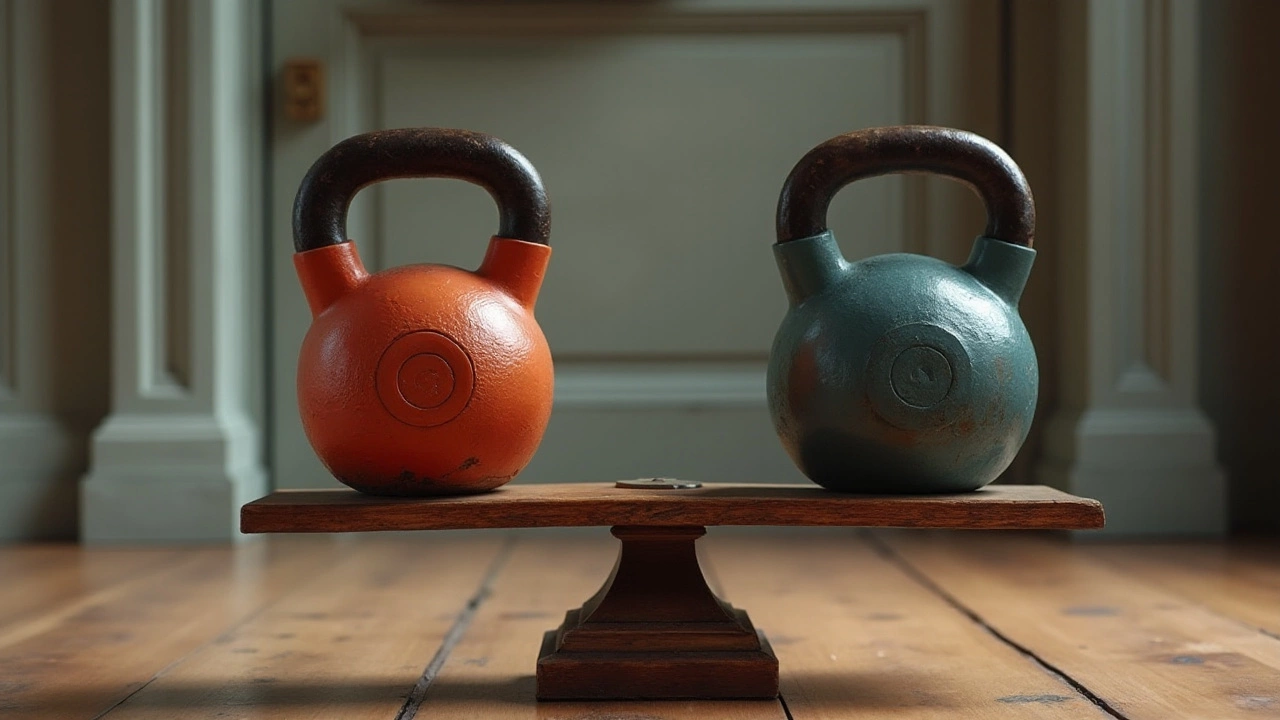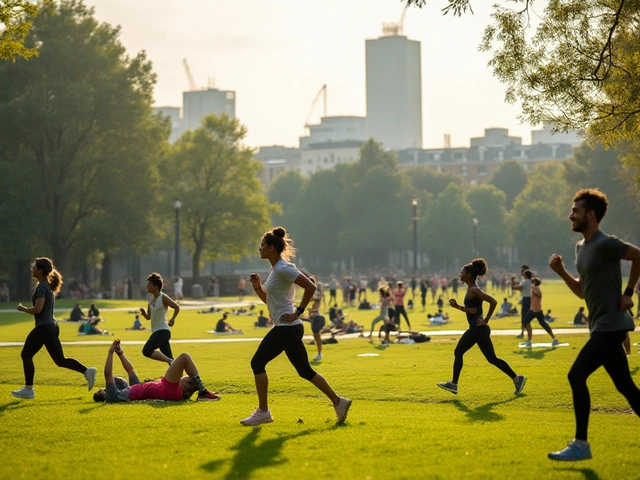Is 2-Hour Daily Gym Workout Beneficial or Excessive?

Finding the right balance in workout duration can significantly affect your fitness journey. Some swear by lengthy gym sessions, believing more is always better, while others advocate for shorter, intense workouts. When we consider spending two hours daily in the gym, questions naturally arise about its effectiveness and safety.
To decide whether this approach fits your lifestyle and goals, it's essential to explore both the potential benefits and drawbacks. Delving into these aspects will not only guide you in optimizing your workout plans but also help in preventing possible injuries from overtraining. Let's take a closer look at what working out for two hours a day truly entails.
- Understanding Workout Demands
- Benefits of Long Workouts
- Risks and Signs of Overtraining
- Balancing Intensity and Recovery
- Customizing Your Fitness Routine
- Alternatives to Long Workouts
Understanding Workout Demands
Embarking on a consistent gym workout routine requires more than just motivation; it involves understanding the various demands it places on your body and mind. When we talk about dedicating two hours each day to exercise, it's important to comprehend not only the physical toll but the overarching impact on lifestyle and well-being. Regular workouts, especially extensive ones, ramp up energy expenditure significantly, which might sound beneficial, but needs balance. For instance, depending on the intensity, you can expect to burn between 600 to 1200 calories in a two-hour session, depending on factors such as body weight and workout type. Yet, this comes with a need for appropriate nutritional intake and hydration to fuel and recover the body.
The choice of exercises typically varies greatly in such lengthy workouts, encompassing cardiovascular activities, strength training, flexibility work, or even sports. Each of these components stresses different muscle groups and systems within the body, requiring not only strength but a good understanding of their effects. Aerobic exercises like running or cycling enhance endurance but can deplete glycogen stores quickly, necessitating replenishment through balanced meals. Strength training, critical for muscle growth and increased metabolism, demands proper form and technique, to avoid injuries. Moreover, pushing muscles to their limits every day without giving them time to repair can lead to overuse injuries, which even seasoned athletes aren't exempt from.
The Mental Forest of Working Out
While physical demands are evident, mental challenges are equally present in fitness routines of this magnitude. Committing to long sessions daily requires a substantial degree of mental fortitude and discipline. The monotony and exhaustion can take a toll on mental health, manifesting in burnout or even a loss of enthusiasm for activities formally enjoyed. To buffer against these effects, variety is often injected into workouts, giving the mind and body different types of stimuli. Advances in technology, like fitness trackers and virtual coaches, offer a way to keep things interesting and challenge personal limits intelligently.
"Exercise is king. Nutrition is queen. Put them together and you've got a kingdom." - Jack LaLanne, a renowned fitness pioneer.
Incorporating rest days or active recovery is crucial in maintaining interest and ensuring sustainable progress. Understanding these demands is not just a matter of knowledge; it's a practice of listening to your body and adjusting your routine to align with its needs. This approach helps in building a comprehensive, enjoyable, and sustainable fitness journey. With so much involved, the journey isn't just about the sweat and the reps; it's about constructing a resilient and well-rounded approach to wellness.
Benefits of Long Workouts
Working out for extended periods, such as two hours a day, can offer substantial benefits, particularly for those dedicated to improving their body’s endurance and honing their discipline. Engaging in long workouts allows individuals to cover diverse fitness zones during a single session. From aerobic exercises to strength training, each major muscle group can get the attention it deserves. This comprehensive approach ensures a balanced development, often necessary for athletes or those pursuing specific fitness goals like triathlons.
One of the often-discussed advantages of long gym workouts is the sheer volume of calories burned. An extended session that combines cardio with resistance exercises effectively keeps your heart rate elevated, maximizing caloric expenditure. This can be particularly beneficial for those aiming to shed pounds. A prolonged workout also means more time to improve endurance. As stamina builds over time, everyday activities become easier, enhancing the quality of life. Not to mention, the mental resilience developed through sustained physical effort is a win for both the body and mind.
There's something particularly rewarding about taking the time for a long workout and knowing that each exercise contributes directly to more significant fitness gains. It fosters a sense of commitment, allowing individuals to immerse themselves deeply in the rhythm of their routine without feeling rushed. Ample time also makes it easier to incorporate essential elements such as warm-ups, cool-downs, and stretching, minimizing the risk of injuries. As the famous trainer Jillian Michaels once said,
"Transformation is not a future event, it is a present activity." The time invested each day lays the groundwork for noticeable, lasting results.
Another compelling benefit is the opportunity for social interactions. People often use workout sessions as a time for bonding, which can further motivate consistency. When workouts last longer, it opens up space for attending group classes where you can interact with instructors or exercise buddies, creating a supportive environment. Studies indicate that spending more time in the gym often leads to improved learning of techniques, as practicing movements repeatedly for two hours reinforces muscle memory. It's not only about the physical gains but also about mastering the art of movement and acquiring a deeper understanding of your body.
On top of everything, people working out for extended periods often find themselves with a broader selection of exercises to perform at a leisurely pace. This allows for experimentation, exploring new machines or classes, like yoga or spinning, without feeling pressured to skip important parts of the workout due to time constraints. While shorter workouts might prioritize intensity, longer sessions can become a crucial part of an evolving fitness journey, offering variety, growth, and an all-encompassing approach to one's health and wellbeing.

Risks and Signs of Overtraining
Stepping into the world of fitness can be exhilarating, but the enthusiasm must be tempered with wisdom, especially when long hours in the gym are on the table. Overtraining is a real and prevalent risk that can derail months of hard work if not identified and addressed promptly. At its core, overtraining syndrome is the body's response to excessive physical stress without adequate rest. This lack of balance can lead to a cascade of physical and psychological symptoms, effectively setting back your fitness goals.
One of the most common indicators of overtraining in the context of gym workouts is persistent fatigue. It's more than just feeling tired for a day or two; it's a deep sense of exhaustion that lingers, no matter how much you rest outside of the gym. This fatigue can severely impact daily life and productivity, often leading to burnout. Another significant sign is a noticeable decrease in performance. Despite your rigorous training, you might find yourself unable to lift weights that were manageable a few weeks ago, or your stamina might falter during cardio sessions.
Physically, the body starts to rebel against the demands placed upon it. Frequent injuries become a feature rather than a rarity. Joints might feel stiff or achy, and muscles could experience persistent soreness. This is the body's way of crying out for rest and recovery, tools vital to any successful fitness routine. Exercise duration that keeps pushing boundaries without reprieve can lead to such situations. According to Dr. Matt Tanneberg, a sports chiropractor, "Overtraining can lead to overuse injuries like stress fractures, tendonitis, and chronic kept strains."
"In simple terms, the body is no longer able to repair the damage caused by intense physical activity as rapidly as required," he adds.
The psychological impact must not be underestimated either. Overtraining can lead to mood swings, irritability, and even depression, stripping the joy from activities that once felt rewarding. This mental toll is compounded by difficulty sleeping, resulting in a vicious cycle of frustration and lack of motivation. Troublingly, these emotional symptoms can often be overlooked or attributed to external stressors unrelated to the gym. Monitoring these psychological flags is critical when engaging in fitness routines that verge on the intense.
If overtraining is suspected, measures must be taken immediately to prevent long-term consequences. Recovery is indispensable and might involve adjusting workout intensity or frequency, prioritizing sleep, and incorporating rest days into the weekly schedule. However, recovery doesn't just mean lounging around—it involves proactive steps like engaging in low-impact activities or yoga, which can help in the rejuvenation process. Often underestimated, nutrition plays a significant role as well. Ample protein intake aids muscle repair, while carbohydrates replenish glycogen stores. Hydration is equally important, ensuring that the body can perform optimally even at rest.
The dangers of overtraining highlight the necessity of a balanced approach to exercise. Alternating days of intense workouts with light to moderate activities or rest ensures the body has time to adapt and grow stronger, avoiding the pitfalls of chronic fatigue and injury. Remember, more isn't always better. Listening to your body and heeding its signals can significantly aid in crafting a sustainable, effective workout routine.
For those wondering if they've been pushing too hard, maintaining a journal can be incredibly insightful. Documenting workouts, noting feelings of fatigue, and tracking performance challenges can help identify patterns suggesting overtraining before reaching critical levels. While the allure of reaching gym milestones can be strong, stepping back to evaluate one's health is paramount. After all, achieving long-term fitness goals is the true measure of success, transforming the gym into a lifelong ally rather than an adversary.
Balancing Intensity and Recovery
As you embark on a fitness journey, one vital aspect to bear in mind is the delicate equilibrium between workout intensity and recovery. Your body thrives on variety and adaptation, which means it is crucial to alternate between pushing your limits and allowing sufficient time to heal and rebuild. Overloading your muscles with extended gym workouts might seem like the fast track to fitness, but without adequate recovery, this can lead to diminishing returns.
Imagine your muscles as tiny sponges. Each time you work out, you're squeezing them, letting out water but simultaneously encouraging new water to fill them when they rest. If you squeeze incessantly without pauses, over time, you'll find them dry and brittle. The same principle applies to muscles; they require rest to repair the microscopic tears caused during exercise and to grow stronger. Without giving the muscles this rest, the risks include injury and fatigue.
Cited studies show that elite athletes often spend equal or more time on recovery strategies as they do on training. Kevin Tipton, a renowned sports nutrition researcher, once stated, “An athlete only achieves optimal gains by combining physical effort with strategic recovery.”
Recovery isn't just about time off from physical activity; it also involves nutrition, hydration, and sleep. Your diet should support your energy demands, focusing on proteins for muscle repair, carbohydrates for refueling glycogen stores, and fats for maintaining hormonal balance. Sleep, often called nature’s nurse, plays a pivotal role in recovery, as growth hormone levels are elevated during deep sleep stages, promoting the repair of tissues.
Fitness routine customization is vital, as not all bodies respond uniformly to the same stimuli. Listen to your body—is it showing signs of exhaustion or a plateau in progress? Then it's potentially time to ease off on the workout throttle and increase recovery measures. Consider employing techniques like active recovery, yoga, or stretching, which keep blood flowing and aid in the removal of metabolic waste products. These activities assist in maintaining flexibility and prevent stiffness, often a precursor to injury.
An effective way to organize your schedule is incorporating a periodized approach to training. This involves varying your workout intensities and volumes over different phases, a method used historically to enhance athletic performance. Here’s how you might structure a week:
- Monday: High-intensity cardio with moderate weights
- Tuesday: Active rest with yoga or a light jog
- Wednesday: Strength training focusing on different muscle groups
- Thursday: Rest day with emphasis on stretching
- Friday: High-intensity interval training (HIIT)
- Saturday: Cross-training, such as swimming or cycling
- Sunday: Complete rest or a leisurely walk
Monitoring your progress and responses to these workouts can aid in tweaking areas that don't meet your fitness goals efficiently. Remember, recovery is as much an art as it is a science. Balancing your exercise intensity with ample rest allows for not only sustainable improvements but also prolonged engagement and enjoyment in your fitness endeavors.

Customizing Your Fitness Routine
In the vast world of fitness, one size certainly does not fit all. Creating a personalized gym workout plan aligned with your unique goals, lifestyle, and body type is important. Whether you aim to build muscle, increase endurance, or simply improve your overall health, making sure your routine is tailored to your needs can make a big difference. To start, assess your current fitness level and clearly define what you wish to achieve. You might want to write down your goals, whether they're short-term milestones like running a 5K or long-term aspirations such as losing a specific amount of weight. Knowing these objectives helps in shaping a customized plan, ensuring you focus on exercises that target the right muscles or improve specific capabilities like stamina or flexibility.
It happens quite often that many are tempted by standard workouts found online or recommended by friends. However, what works for someone else might not work for you due to differences in physical health, genetic predispositions, and personal commitments. Crafting a gym workout that fits within your schedule is crucial; consider your work and family obligations, and how you can weave your exercise sessions seamlessly into your daily routine. This consistency is key for sustained progress. According to renowned fitness trainer, Mark Verstegen, "Your program should work as hard as you do, allowing flexibility while staying focused on your goals."
Your program should work as hard as you do, allowing flexibility while staying focused on your goals.
Learning the value of balance and flexibility in your fitness routine is an invaluable part of this customization process. Integrate both cardiovascular activities and strength training into your weekly routine to cover all bases. Cardio could be in the form of running, cycling, or swimming, providing your heart and lungs with a healthy workout while burning calories. Strength training, on the other hand, enhances muscle mass, promotes bone density, and even boosts metabolic rate. Alternating focus between these types of exercises prevents the risk of injuries and boredom. Aim to have about two to three cardio sessions complemented by two to three strength-training sessions each week. Exercise duration is also a crucial aspect to consider; while two hours might be suitable for advanced enthusiasts training for specific events, not everyone requires such long sessions.
Incorporating rest and recovery into your plan cannot be underestimated. Muscles need time to repair and grow after intense workouts, making rest days a non-negotiable component of a successful program. Studies have shown that overtraining without adequate rest can lead to diminished performance and even predispose you to injuries. Hence, ensuring your week includes at least one or two rest days will provide the necessary recovery time, elevating your overall results. During these days, you might engage in light activities like walking or yoga, promoting leisure while remaining active. Considering all these factors helps you develop a balanced fitness routine that you can maintain for the long term.
Remember that evolving your fitness routine as you progress is just as vital as customizing it at the start. Your body will adapt to exercises over time, making it important to periodically review and adjust your plan. Whether it means increasing weights, trying new activities, or adding intensity, periodic evaluations ensure continued growth and prevent plateaus. Keeping an exercise journal aids in tracking workouts, dietary habits, and changes in physical abilities, offering insights into what works best for you. With the advent of technology, fitness apps serve as handy tools to remind and motivate, tracking progress while offering variability to keep your workouts exciting. So, embrace the journey of sculpting your very own gym workouts tailored just for you, because when it comes to achieving fitness goals, personalization is potent.
Alternatives to Long Workouts
Striking a perfect balance between efficiency and effectiveness in gym workouts doesn't always mean clocking in long hours. The key lies in discovering alternative workout strategies that fit into your schedule without sacrificing results. Many fitness aficionados are turning to shorter, more intense gym workouts that deliver results in less time. High-Intensity Interval Training, or HIIT, is a popular workout regimen known for its quick, powerful bursts of energy followed by short periods of rest. This method not only incinerates calories but also boosts cardiovascular health. Studies reveal that a mere 20-minute HIIT workout can offer similar benefits to a two-hour traditional session. That's quite a revelation for people with packed schedules!
Functional training is another brilliant alternative, helping you build strength while burning fat in record time. It mimics everyday movements, engaging different muscle groups at once. With exercises like squats, lunges, and burpees, you're training your body comprehensively. Circuit training follows a similar principle, blending both strength and cardio elements for a holistic workout in a concise time frame. Imagine cycling between exercises with minimal rest, constantly keeping your heart rate elevated while sculpting muscles. These are not only efficient but incredibly versatile, suitable for people of all ages and fitness levels.
According to the American Heart Association, "Adults should get at least 150 minutes of moderate-intensity aerobic activity every week for optimum health benefits." This can be easily achieved by incorporating short daily sessions.
Yoga and Pilates present potent options that prioritize flexibility, core strength, and mindfulness. These low-impact workouts are notorious for reducing stress while enhancing your core stability and posture. They're less about sweat and more about finesse, offering a balanced approach to fitness that often gets overlooked. Even walking, widely underestimated, is a fantastic alternative. A brisk 30-minute walk can help maintain a healthy weight, strengthen your bones, and boost your mood. Pair it with the beauty of nature, and you have a mental health boost on top of physical fitness. An emerging trend is virtual workouts, an attractive option for those unable to visit the gym regularly. With a plethora of apps and videos, you can squeeze in a guided session whenever you have a spare moment. Your options are endless from celebrity trainers to expansive libraries of various workout styles.
Consider also the pros of quick workout apps that cater to modern life demands. They're crafted for home environments, allowing you to exercise on your terms. Many offer customizable plans, helping you target specific fitness goals effectively. Not to mention the savings on travel time and membership costs. Recent user reviews highlight their practicality, especially in the dead of winter when heading out can be a chore. Exercise duration isn't the sole parameter for fitness. It's about quality and consistency over quantity, pushing your limits safely while enjoying the process. As the landscape of fitness evolves, embracing these alternatives can redefine how we approach our daily grind at the gym, making every minute truly count.



